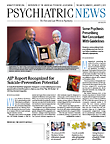A study linking early identification of young people at high risk for psychosis with psychosocial interventions and psychotropic medication found improvements in symptoms, general assessment of functioning, and other outcomes, according to researchers working in six U.S. cities.
The Early Detection and Intervention for the Prevention of Psychosis Program (EDIPPP) employed a range of psychosocial interventions as well as targeted use of psychotropic medications to achieve a statistically significant improvement in positive symptoms, the primary outcome measure.
“Family intervention is the principal treatment component, based on the evidence for its efficacy in schizophrenia and prodromal psychosis,” wrote William McFarlane, M.D., and colleagues in the January Schizophrenia Bulletin. McFarlane is affiliated with the Maine Medical Research Institute in Portland and is a professor of psychiatry at Tufts University School of Medicine.
A total of 337 people aged 12 to 25 were recruited through community and clinical outreach efforts. They were assigned to one of three cohorts: clinically lower risk (CLR), clinically higher risk (CHR), or early first episode of psychosis (EFEP). Those with CHR or EFEP were the intervention groups, based on positive symptom scores, and CLR subjects were controls.
“The risk-based allocation, regression-discontinuity design has been used in justice studies and in other areas of medicine, but not in psychiatry,” said McFarlane in an interview with Psychiatric News. “It is very powerful and protects extreme ends of the clinical spectrum from being assigned to the wrong treatment.”
The two intervention cohorts in the study received psychoeducational, multifamily, group therapy sessions; supported education and employment; and psychotropic medication based on patient need, a program collectively called Family-aided Assertive Community Treatment, or FACT.
The CLR group received community care, and about 76 percent of that group got individual therapy, antipsychotic or antidepressant medications, and/or supported education or employment.
The high rate of treatment in the control group, said McFarlane, “may be an effect of informing parents referred to the study by schools or pediatricians,” and it should buttress the study’s results.
All three cohorts improved, and at 24 months the CRH and EFEP groups saw statistically significant improvements compared with the CLR group.
“FACT is effective in improving positive, negative, disorganized, and general symptoms; Global Assessment of Functioning; work and school participation; and global outcome in youth at risk for, or experiencing, very early psychosis,” the authors concluded.
Conversion to psychosis occurred with 6.3 percent of the CHR patients and 2.3 percent of the CLR group, but the difference was not significant.
The report came amid increasing interest in finding and treating psychoses earlier in the course of psychopathology, and it stimulated a number of comments following its first publication online last July, as William Carpenter, M.D., the journal’s editor in chief and a professor of psychiatry at the University of Maryland, intended.
“We wanted to run the article to promote a discussion, and the comments are designed to extend the readers’ understanding,” Carpenter told Psychiatric News.
For a start, the report provided “substantial new data … bearing on the practicality and effectiveness of early intervention,” wrote Carpenter and Robert Buchanan, M.D., also a professor of psychiatry at the University of Maryland, in one of several accompanying editorials,
However, the “unusual methodology and statistical analysis” employed limited interpretation of the results and created controversy, they added.
“The fact that treatment assignments were not randomized means it is hard to draw a conclusions,” said Carpenter.
McFarlane disagreed.
“Risk-based allocation and regressions discontinuity design, though quasi-experimental technically, has developed over its 50-year history to the point that in large samples, as in EDIPPP, statistically significant differences between control and experimental treatments have the same inference as they would in a randomized, controlled trial,” he told Psychiatric News. “For that reason, we do not accept the comments that EDIPPP outcomes were not controlled or that there are major limitations to interpretation of the data.”
Other commentators asked whether some families might prefer family services other than group therapy, the primary intervention.
“When a family declined multifamily group participation, they were offered the single-family version of the same treatment protocol,” replied McFarlane, noting that this information was available in online supplementary material. “We have always recommended that families receive whichever form they prefer, while explaining that the multifamily group format is preferable for early stages of psychosis and that, after participating, most families prefer the multifamily group.”
The family intervention used in the EDIPPP had a much more significant effect than the antipsychotic drugs, said McFarlane.
Carpenter and McFarlane did agree on another point. The program could be scaled up to care for larger populations only if it was given sufficient resources, a problem when the American mental health system is “in tatters,” said McFarlane.
“I have a lot of reason to believe this integrated treatment approach would have a robust effect because family education and involvement and supported employment are known to have their benefits,” said Carpenter. “So if you have statistical separation, there would be clinically meaningful effects, but the limitations of the study design means we are hesitant to make inferences.” ■
“Clinical and Functional Outcomes After 2 Years in the Early Detection and Intervention for the Prevention of Psychosis Multisite Effectiveness Trial” can be accessed
here. “Early Psychosis Intervention Services: A Work in Progress” is available
here. “Early Intervention: How Early and With What?” is posted
here.

